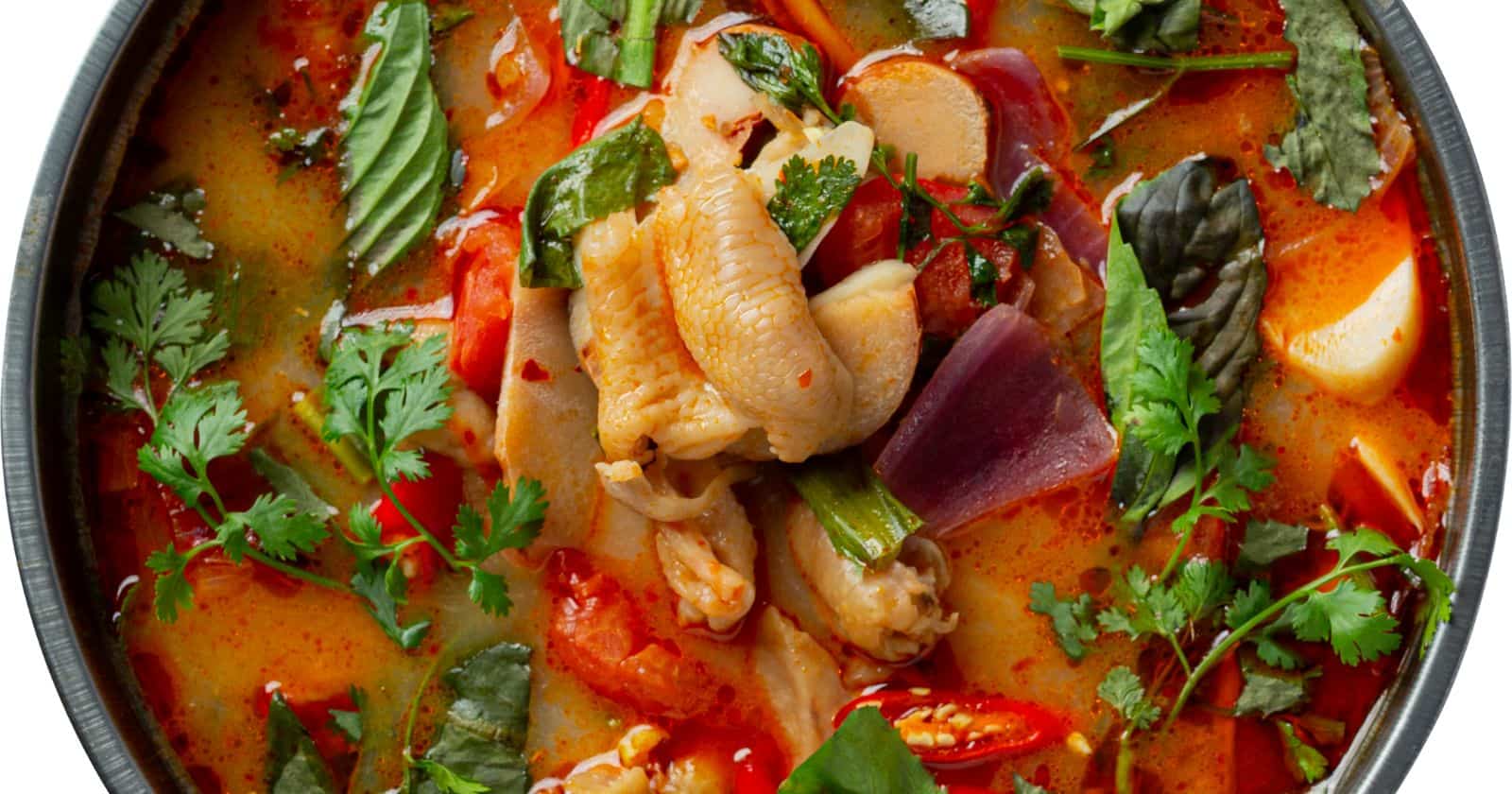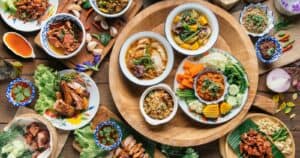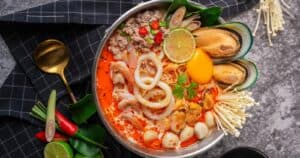Craving fiery green curry but wary of dairy? Many assume Thai food is strictly dairy-free. But some ingredients may surprise you.
This article dispels myths about dairy in Thai cooking. You’ll learn which dishes contain hidden dairy and how to navigate menus to enjoy the tasty cuisine, even with dietary restrictions.
Is Thai Food Naturally Dairy-Free?
Here’s the short answer:
Authentic Thai cuisine is largely dairy-free. Dishes rely on ingredients like herbs, spices, rice, noodles, vegetables, and proteins like seafood, chicken or tofu.
However, some exceptions exist. Certain sauces, desserts, or dishes catering to Western tastes may incorporate dairy products.
The key is understanding where dairy hides in Thai food so you can enjoy the flavorful cuisine, whether you avoid dairy completely or just want healthier options.
Next, let’s explore…
Why Thai Cuisine Traditionally Avoids Dairy
Several factors explain why dairy isn’t a huge part of Thai food’s flavor profile:
Cultural Influences
Dairy was not a large part of the Southeast Asian diet historically. Cow’s milk and cheeses were not staples.
Climate
Thailand’s tropical climate makes dairy production challenging. Fresh dairy products spoil quickly in the heat.
Flavor Profile
Thai cuisine highlights fresh herbs, citrus, chilies, and spices—not subtle dairy flavors.
Religion
Many Thai people follow religious traditions that encourage plant-based eating over dairy-rich diets.
Allergies
Dairy allergies and lactose intolerance are common in East Asia, spurring dairy-free cuisine.
Next, let’s look at the dairy-free ingredient integral to Thai cooking.
Coconut Milk: The Thai Cuisine Substitute
Since dairy is not a tradition, what provides the cool creaminess in so many Thai dishes?
Coconut milk!
This dairy-free alternative offers:
- Rich, creamy texture
- Subtle natural sweetness
- Neutral flavor that complements spices
- High cooking temperature stability
Coconut milk shines in:
- Curries
- Soups
- Stews
- Sticky rice dishes
It delivers the luxurious mouthfeel diners expect without actual dairy.
But a few specific dishes do diverge from the traditional dairy-free norm…
When Thai Food Does Contain Dairy
Most Thai cuisine is dairy-free, but exceptions exist:
Some Desserts
Sweets like mango sticky rice with condensed milk or coconut ice cream with dairy milk.
Dishes Catering to Tourists
Restaurants may add butter, cream, or cheese to Thai dishes to appeal to Western palates.
Adapted Home Cooking
Home cooks may substitute dairy for coconut milk in traditional recipes.
Some Restaurant Sauces
Certain dipping sauces or curry pastes could contain traces of dairy as flavorings.
The key is checking menus and asking questions if you want to avoid dairy. Don’t assume traditional dish recipes are dairy-free.
Next, let’s talk about hidden dairy lurking in one pantry staple…
The Potential Dairy in Soy Sauce
Soy sauce is a ubiquitous Thai ingredient. But here’s the catch:
Some soy sauce contains gluten and dairy as hidden ingredients.
This is because traditional soy sauce uses fermented wheat in the brewing process. The wheat adds gluten.
Some brands also add milk proteins or lactose during fermentation. This incorporates traces of dairy.
The solution?
Seek out tamari sauce. Tamari is the gluten-free, dairy-free alternative. It’s brewed without wheat or dairy additives.
Checking labels and asking restaurants about soy sauce ingredients ensures you get the dairy-free experience you want.
Spotting Hidden Dairy in Thai Restaurant Foods
Even if you carefully select a Thai dish that seems dairy-free, some menu items may contain sneaky sources of dairy. Be on the lookout for:
Fried Dishes with Batter
Fried appetizers like spring rolls or entrees like fried fish may use a batter that contains milk or cheese ingredients. Always ask about batter ingredients.
Creamy Salad Dressings
Thai salads or papaya salads are usually dairy-free. But some restaurants may dress them with creamy dressings made from yogurt, sour cream or mayonnaise. Check first.
Noodles or Rice Topped with Cheese
While pad thai and other noodle or rice dishes are traditionally dairy-free, some restaurants catering to Western tastes may add a garnish of cheese or creamy sauce.
Butter or Cream-Based Sauces
Many Thai curries and stir-fries get their richness from coconut milk. But some restaurants use dairy-based sauces with butter, cream or cheese instead. Ask about sauce ingredients.
Brothy Soups
Soups like tom yum are generally dairy-free, but some restaurants may finish them with a swirl of cream or dollop of butter. Check before ordering.
Desserts
While Thai desserts are traditionally dairy-free, restaurants may offer Western options like ice cream, chocolate mousse or Creme brûlée. Opt for fresh fruit or dairy-free coconut ice cream instead.
By double checking each menu item and asking questions, you can enjoy the true flavors of Thai cuisine without the unpleasant surprise of hidden dairy.
Communicating Dairy Restrictions at Thai Restaurants
Dining out while avoiding dairy means arming yourself with the right dining-out tactics:
Research Menus in Advance
Look for dishes without coconut milk or dairy-based sauces. Curries, noodle dishes, and stir fries are often dairy-free.
Explain Your Restrictions
Tell staff you must avoid dairy due to allergies or intolerance. Ask for guidance.
Inquire About Hidden Dairy
Ask if menu items contain soy sauce, condensed milk, cream, cheese or butter.
Request Modifications
Ask for dishes to be prepared without dairy ingredients or suggest substitutions.
Consider Vegan Restaurants
Thai restaurants catering to vegan diners offer more dairy-free assurance.
Double Check Desserts
Many Thai desserts contain coconut milk or dairy. Opt for fresh fruit instead.
With some preparation and staff communication, you can enjoy the authentic Thai cuisine experience minus the dairy.
Easy Home Cooking Substitutions
Whipping up Thai favorites at home? Swap in these dairy-free alternatives:
Coconut milk – Use plain, unsweetened coconut milk in place of dairy milk or cream in curries, soups, sauces, or sticky rice.
Soy or oat milk – For drinking or desserts, substitute soy, oat, or other non-dairy milk.
Dairy-free cheese – Sprinkle on vegan cheese made from nuts or coconut milk for a creamy, salty accent.
Avocado – Swap mashed avocado for mayo or sour cream as a condiment or dipping sauce.
Vegan butter/ghee – Use non-dairy butter or ghee made from oils when recipes call for butter.
Banana ice cream – Blend frozen bananas with coconut milk and spices for dairy-free “nice cream.”
With some easy kitchen swaps, you can recreate Thai classics to be dairy-free and still full of flavor.
Managing Lactose Intolerance with Thai Cuisine
Lactose intolerant foodies can satisfy their Thai food cravings with these tips:
Choose Coconut-Based Curries
Red, green, yellow and massaman curries use dairy-free coconut milk rather than cream. Load up on veggies for a filling meal.
Pick Stir Fries and Rice Dishes
Classic pad thai, basil chicken, and pineapple fried rice are all tasty lactose-free choices.
Avoid Creamy Pasta Entrees
Some Thai restaurants cater to Western tastes with creamy pasta dishes. Stick to traditional Thai recipes instead.
Enjoy Fresh Mango for Dessert
Sweet, juicy mango makes the perfect lactose-free dessert. Resist the urge to order ice cream.
Request Soy or Almond Milk
Opt for soy, almond, or coconut milk in your tea or coffee instead of regular dairy milk.
Inquire About Hidden Lactose
Ask if menu items, sauces, dressings or soups contain hidden lactose you should avoid.
Take Lactase If Needed
Carry lactase enzyme tablets to take before your meal if you can tolerate small amounts of lactose.
With mindful menu choices and effective communication, lactose intolerance doesn’t have to get in the way of amazing Thai cuisine. You can savor all the flavors you love lactose-free.
Enjoying the Flavors of Thailand Dairy-Free
Some diners generalize and assume no Thai food contains dairy. But as we’ve dispelled, traces of dairy can lurk in surprising places.
The good news? With care and customization, dairy-free eaters can immerse in the full spectrum of Thai cuisine.
Here are some final tips for enjoying Thailand’s vibrant flavors minus the dairy:
Learn hidden dairy sources – Soy sauce, desserts, and Westernized fare often hide traces.
Study menus carefully – Scout dishes free of coconut milk, cheese, butter, and cream.
Explain your needs clearly – Work with restaurants to make simple swaps or omissions.
Explore regional varieties – Each Thai region has unique dairy-free specialties to discover.
Cook dairy-free at home – Get creative with coconut milk, non-dairy cheese, avocado, nut milk, and more.
Savor the experience! – Immerse all your senses in textures, aromas, colors and flavors.
With the right insights and strategies, dairy-free foodies can experience the diversity of Thai cuisine. So grab those chopsticks to enjoy coconut curry, green papaya salad, or mango sticky rice minus the dairy! Your taste buds will thank you.





